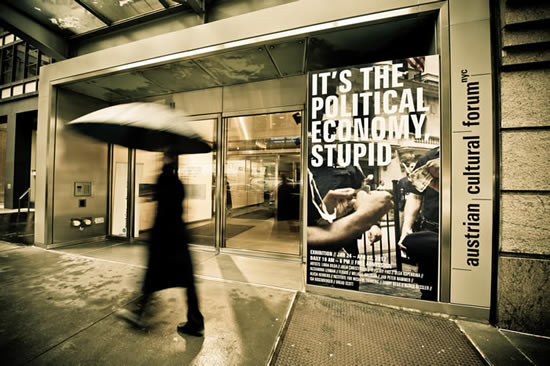It's the Political Economy, Stupid

Photo: David Plakke
The show derives its name from the slogan originally coined by James Carville, which in the early 1990s came to define Bill Clinton’s presidential campaign. The premise of the exhibit is that the economic crisis that we face today has also become a major crisis for representative democracy. The very idea of the modern nation state is in jeopardy as the deterritorialized flow of finance capital melts down all that was once solid into raw material for market speculation.
It is the social order itself, and the very notion of governance with its archaic promise of security and happiness that has become another kind of modern ruin. It’s the Political Economy, Stupid brings together an international group of artists who focus on the current crisis in a sustained and critical manner. Rather than acquiesce to the current calamity, this exhibition asks if it is time to push back against the disciplinary dictates of the capitalist logic and, by use of artistic means, launch a rescue of the very notion of the social itself.
The exhibition includes documentarian approaches, such as works by Julia Christensen, who explores the transformation of defunct Big Box stores throughout the U.S. as an example of the resilience and resourcefulness of those affected most by the crisis. A piece by Yevgeniy Fiks, Olga Kopenkina, and Alexandra Lerman, documents those who have the experience of working in the corporate environment, the field of finance, as well as several professors of economics as they participate in a discussion about Vladimir Lenin and his ideas about finance capitalism.
Films by Jan Peter Hammer and Melanie Gilligan reflect the artists’ fictionalized takes on the crisis, by drawing historical parallels and showing the microcosmic point of view of those directly involved, respectively. Quite a few artists and collectives took a performative and decidedly actionistic path, all of which represent artistic precursors to the Occupy Wall Street movement: Performance artist Dread Scott literally burned money on Wall Street, until he was stopped by the police.
The flo6x8 group staged flamenco-dancing flashmobs in Spanish banks to protest against the financial system, while Alicia Herrero staged public fora at the National Bank of Argentina, in which experts, artists, and activists discussed theoretical models and ideas for economic and political change. The collective known as the Institute for Wishful Thinking (IWS) tackles the eternal recurrence of the capitalist crisis with a series of site-specific visual commentary on the infamous 1975 New York Daily News headline: “Ford to City: Drop Dead”.
Austrian artist Isa Rosenberger’s piece, Espiral - A Dance of Death in 6 Scenes, takes a 1930s Weimar-era political ballet, and transposes it to reflect the present- day crisis. Zanny Begg and Oliver Ressler employ the medium of animation to explore how governments in the United States, and other places in Europe such as Ireland, managed to turn a banking crisis into a budgetary crisis. As a tangible complement to these video works, Austrian artist Linda Bilda was commissioned to produce a wall mural for the exhibition. Her graphic series The Golden World is a point of departure, as it explores themes such as greed and competition in the monetary world.
It’s the Political Economy, Stupid will be on display at the Austrian Cultural Forum New York until April 22, 2012. Free admission. Open daily 10am - 6pm. For more information visit www.acfny.org
